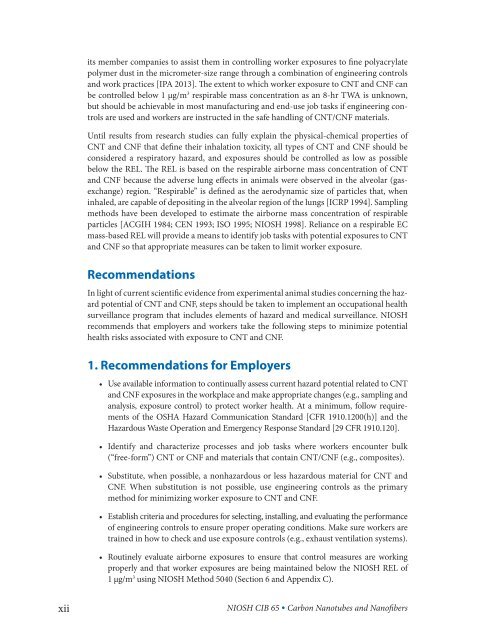Occupational Exposure to Carbon Nanotubes and Nanofibers
Occupational Exposure to Carbon Nanotubes and Nanofibers
Occupational Exposure to Carbon Nanotubes and Nanofibers
You also want an ePaper? Increase the reach of your titles
YUMPU automatically turns print PDFs into web optimized ePapers that Google loves.
its member companies <strong>to</strong> assist them in controlling worker exposures <strong>to</strong> fine polyacrylatepolymer dust in the micrometer-size range through a combination of engineering controls<strong>and</strong> work practices [IPA 2013]. The extent <strong>to</strong> which worker exposure <strong>to</strong> CNT <strong>and</strong> CNF canbe controlled below 1 µg/m 3 respirable mass concentration as an 8-hr TWA is unknown,but should be achievable in most manufacturing <strong>and</strong> end-use job tasks if engineering controlsare used <strong>and</strong> workers are instructed in the safe h<strong>and</strong>ling of CNT/CNF materials.Until results from research studies can fully explain the physical-chemical properties ofCNT <strong>and</strong> CNF that define their inhalation <strong>to</strong>xicity, all types of CNT <strong>and</strong> CNF should beconsidered a respira<strong>to</strong>ry hazard, <strong>and</strong> exposures should be controlled as low as possiblebelow the REL. The REL is based on the respirable airborne mass concentration of CNT<strong>and</strong> CNF because the adverse lung effects in animals were observed in the alveolar (gasexchange)region. “Respirable” is defined as the aerodynamic size of particles that, wheninhaled, are capable of depositing in the alveolar region of the lungs [ICRP 1994]. Samplingmethods have been developed <strong>to</strong> estimate the airborne mass concentration of respirableparticles [ACGIH 1984; CEN 1993; ISO 1995; NIOSH 1998]. Reliance on a respirable ECmass-based REL will provide a means <strong>to</strong> identify job tasks with potential exposures <strong>to</strong> CNT<strong>and</strong> CNF so that appropriate measures can be taken <strong>to</strong> limit worker exposure.RecommendationsIn light of current scientific evidence from experimental animal studies concerning the hazardpotential of CNT <strong>and</strong> CNF, steps should be taken <strong>to</strong> implement an occupational healthsurveillance program that includes elements of hazard <strong>and</strong> medical surveillance. NIOSHrecommends that employers <strong>and</strong> workers take the following steps <strong>to</strong> minimize potentialhealth risks associated with exposure <strong>to</strong> CNT <strong>and</strong> CNF.1. Recommendations for Employers••Use available information <strong>to</strong> continually assess current hazard potential related <strong>to</strong> CNT<strong>and</strong> CNF exposures in the workplace <strong>and</strong> make appropriate changes (e.g., sampling <strong>and</strong>analysis, exposure control) <strong>to</strong> protect worker health. At a minimum, follow requirementsof the OSHA Hazard Communication St<strong>and</strong>ard [CFR 1910.1200(h)] <strong>and</strong> theHazardous Waste Operation <strong>and</strong> Emergency Response St<strong>and</strong>ard [29 CFR 1910.120].••Identify <strong>and</strong> characterize processes <strong>and</strong> job tasks where workers encounter bulk(“free-form”) CNT or CNF <strong>and</strong> materials that contain CNT/CNF (e.g., composites).••Substitute, when possible, a nonhazardous or less hazardous material for CNT <strong>and</strong>CNF. When substitution is not possible, use engineering controls as the primarymethod for minimizing worker exposure <strong>to</strong> CNT <strong>and</strong> CNF.••Establish criteria <strong>and</strong> procedures for selecting, installing, <strong>and</strong> evaluating the performanceof engineering controls <strong>to</strong> ensure proper operating conditions. Make sure workers aretrained in how <strong>to</strong> check <strong>and</strong> use exposure controls (e.g., exhaust ventilation systems).• • Routinely evaluate airborne exposures <strong>to</strong> ensure that control measures are workingproperly <strong>and</strong> that worker exposures are being maintained below the NIOSH REL of1 µg/m 3 using NIOSH Method 5040 (Section 6 <strong>and</strong> Appendix C).xiiNIOSH CIB 65 • <strong>Carbon</strong> <strong>Nanotubes</strong> <strong>and</strong> <strong>Nanofibers</strong>

















